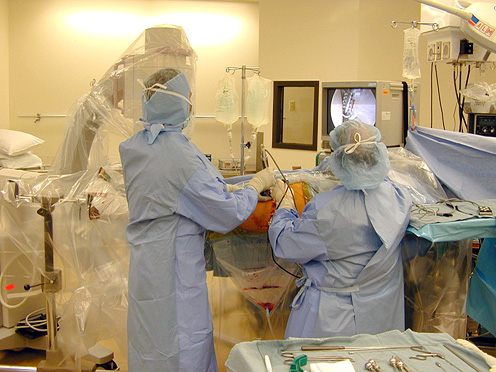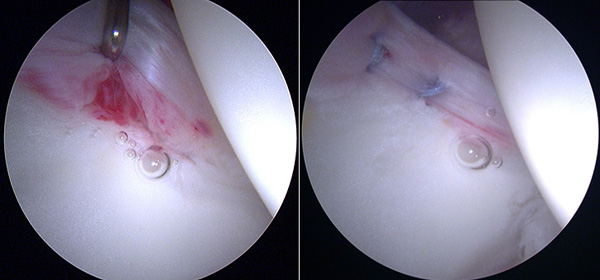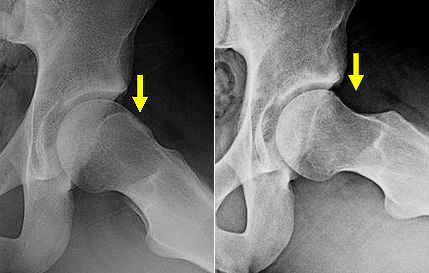Hip arthroscopy is a minimally invasive surgical procedure indicated for the treatment of specific hip disorders. With this procedure, the hip joint is accessed through small incisions. An arthroscope (video camera) monitors the procedure, and specialized instruments are used to work inside the joint. Dr. Clohisy and his team can surgically correct and treat problems in the hip that used to require open surgery with a larger incision and wide exposure of the joint.
Why Would Hip Arthroscopy Be Performed?
Hip arthroscopy can be used to surgically treat many problems of the hip, including:
- Labral tears (damage to the labrum, which acts like a cartilage cuff around the hip socket)
- Surface cartilage (articular cartilage) damage
- Femoroacetabular impingement deformities
- “Snapping hip” syndromes
- Synovitis (inflammation of the joint)
- Early arthritis
- Ligamentum teres rupture
- Loose bodies
- Other uncommon conditions
Dr. Clohisy will discuss whether hip arthroscopy is an appropriate treatment option for your particular hip condition. It is important to note that certain hip conditions are better managed with open procedures. These conditions include hip dysplasia, Perthes deformities, slipped capital femoral epiphysis deformities, and severe forms of femoroacetabular impingement.
The Procedure

Hip arthroscopy is performed on a special surgical table that applies traction and provides access to the joint (shown above). Two to three small incisions are made about the hip and a pencil-thick, tube-like device is inserted into one of the incisions. This device contains a camera or scope which allows the surgical team to get an “inside look” at the hip joint on large monitors in the operating room. The additional incisions (“portals”) are used for other instruments to work inside the joint.

Acetabular labral tear (left panel) is shown prior to and after arthroscopic repair (right panel). The unstable torn labrum is repaired and stabilized to the acetabular rim with two suture anchors
Clear arthroscopic fluid is pumped into the joint to provide clear visualization of the structures inside the joint. Depending on the reason for the procedure, the surgeon will use specialized tools to treat the problems within the joint. Flaps or frayed portions of the articular cartilage (early arthritis) can be shaved away or removed in a process called “debridement or chondroplasty.” Torn cartilage, labral tears, and synovitis can be successfully debrided arthroscopically. Acetabular labral tears can be repaired with “suture anchors.” These devices are anchored in the bone of the hip socket and the attached suture is used to refix the torn labrum. In cases of femoroacetabular impingement, abnormal bone protrusions can be removed with an arthroscopic burr. These bony protrusions may occur along the rim of the socket and/or on the femoral head/neck region.

Preoperative (left panel) and postoperative (right panel) x-rays of a young male patient with FAI. Note arthroscopic recontouring of the femoral head-neck junction to relieve the femoral-sided impingement.
If the articular cartilage in the joint has been lost, small holes may be drilled into flat, bony areas of the hip. This procedure, “microfracture,” encourages the formation of new “repair cartilage” in the area of cartilage loss.
If you are a candidate for hip arthroscopy, Dr. Clohisy will discuss the procedure with you in detail. The details of the procedure will vary for each patient. The goal is to individualize the procedure to specifically address the needs of each patient.
What Can I Expect from Hip Arthroscopy?
Every patient is unique, and the details of hip arthroscopy procedures can vary. In general, hip arthroscopy is performed under general anesthesia. You will be asleep during the procedure and you will not remember your surgery.
The length of the procedure largely depends upon the type of procedure being performed. Most procedures last one to two hours. Hip arthroscopy is often performed on an outpatient basis, but sometimes an overnight hospital stay is required.
What Can I Expect in Recovery from Hip Arthroscopy?
After hip arthroscopy, you will be on crutches for the first one to four weeks. You will be given oral pain medicines to manage the surgical discomfort. Physical therapy will start immediately after surgery with crutch training, gentle range-of-motion and active exercises. A CPM (continuous passive motion) machine will be used for one month to restore motion to the hip and help healing of the joint.
Dr. Clohisy will outline a progressive physical therapy program for you to rebuild strength in the muscles around the hip joint. Most patients require 12 weeks of physical therapy to restore strength and mobility in the hip, but every patient is unique. In six weeks to two months, you should be able to resume most of your normal, everyday activities. However, it may take three to four months for the hip to fully recover from surgery. In many cases, the hip continues to improve for 12 to 18 months after surgery. Return to full sport activity is usually three to four months after the procedure.
Following hip arthroscopy, it is very important to maintain your schedule of routine appointments with Dr. Clohisy and his team so they he can monitor your progress after surgery.
What Are the Potential Advantages to Hip Arthroscopy over Other Treatments?
If you are an appropriate candidate for hip arthroscopy it helps you to avoid a more extensive open surgical procedure to address the problem in your hip. Compared to open surgery, hip arthroscopy may offer certain advantages:
- Smaller incisions
- Outpatient procedure or shorter hospital stay
- Potential for earlier and faster rehabilitation
Who is a Candidate for Hip Arthroscopy?
Hip arthroscopy is less common than knee arthroscopy because the hip joint is deeper in the body (more difficult to access), such that not all procedures can be performed arthroscopically. In general, the typical hip arthroscopy patient is one who is physically active, has hip pain, and a hip disorder that can be addressed with arthroscopic surgery.
What are the Risks and Benefits of Hip Arthroscopy?
All surgical procedures, including minimally invasive outpatient procedures, carry some risks. In general, hip arthroscopy is safe and the major complication rate is low. Potential complications include but are not limited to infection, blood clots, nerve damage, bleeding, fracture, continued pain, heterotopic bone formation, scar tissue formation, instrument breakage, and anesthesia problems.
For those who are appropriate candidates for hip arthroscopy, it may avoid or postpone open hip surgery or delay the need to undergo total hip replacement. In some cases, hip arthroscopy may fully address a hip problem with no need for further surgery.
How Can I Find Out More?
The best way to learn more about hip arthroscopy and whether or not you would be a good candidate for this procedure is to discuss this with Dr. Clohisy. Every patient is different, and our healthcare team can help you determine the best treatment option for your hip disorder.